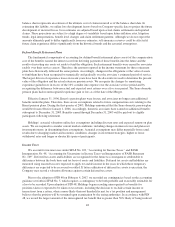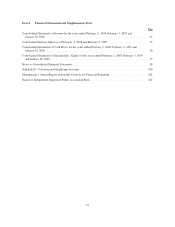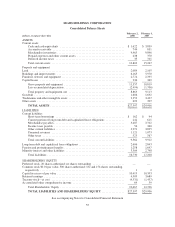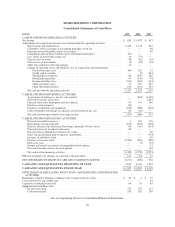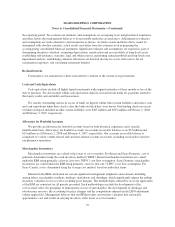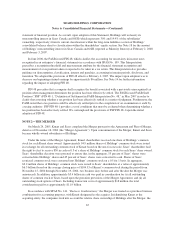Sears 2007 Annual Report Download - page 58
Download and view the complete annual report
Please find page 58 of the 2007 Sears annual report below. You can navigate through the pages in the report by either clicking on the pages listed below, or by using the keyword search tool below to find specific information within the annual report.
SEARS HOLDINGS CORPORATION
Notes to Consolidated Financial Statements
NOTE 1—SUMMARY OF SIGNIFICANT ACCOUNTING POLICIES
Nature of Operations, Consolidation and Basis of Presentation
Sears Holdings Corporation (“Holdings,” “we,” “us,” or the “Company”) is the parent company of Kmart
Holding Corporation (“Kmart”) and Sears, Roebuck and Co. (“Sears”). Holdings was formed as a Delaware
corporation in 2004 in connection with the merger of Kmart and Sears (the “Merger”), which was completed on
March 24, 2005. We are a broadline retailer with 2,317 full-line and 1,150 specialty retail stores in the United
States operating through Kmart and Sears and 380 full-line and specialty retail stores in Canada operating
through Sears Canada Inc. (“Sears Canada”), a 70%-owned subsidiary. We have three reportable segments,
Kmart, Sears Domestic and Sears Canada.
For accounting purposes, the Merger was treated as a purchase business combination, with Kmart acquiring
Sears. Accordingly, the historical financial statements of Kmart serve as the historical financial statements of
Holdings, the registrant. The results of Sears are included in the consolidated financial statements subsequent to
the Merger date. As a result, Holdings’ operating results for fiscal 2005 include approximately 44 weeks of
Sears’ results and 52 weeks of Kmart’s results. See Note 2 for summary unaudited pro forma information and
details on the purchase accounting applied to the Merger.
The consolidated financial statements include all majority-owned subsidiaries in which Holdings exercises
control. Investments in companies in which Holdings exercises significant influence, but which we do not control
(generally 20% to 50% ownership interest), are accounted for under the equity method of accounting.
Investments in companies in which we have less than a 20% ownership interest and do not exercise significant
influence are accounted for at cost. All intercompany transactions and balances have been eliminated.
Fiscal Year
Effective March 23, 2005, we changed our fiscal year end from the last Wednesday in January to the
Saturday closest to January 31st. In fiscal 2006, the Saturday nearest January 31st was February 3, 2007 and as a
result, fiscal 2006 consisted of 53 weeks, with the additional week occurring in the fourth quarter. Both fiscal
2007 and fiscal 2005 consisted of 52 weeks. Unless otherwise stated, references to years in this report relate to
fiscal years rather than to calendar years. The following fiscal periods are presented in this report.
Fiscal year Ended Weeks
2007 February 2, 2008 52
2006 February 3, 2007 53
2005 January 28, 2006 52
Sears Canada’s fiscal year end has historically been the Saturday closest to December 31st and accordingly,
we consolidated Sears Canada’s results on a one-month lag. During the fourth quarter of 2007, Sears Canada
changed its fiscal year end from the Saturday nearest December 31st to the Saturday nearest January 31st. See
Note 3 of Notes to Consolidated Financial Statements for further explanation of this change.
Use of Estimates
The preparation of financial statements in conformity with accounting principles generally accepted in the
United States of America requires management to make estimates and assumptions about future events. The
estimates and assumptions affect the reported amounts of assets and liabilities and disclosure of contingent assets
and liabilities at the date of the financial statements, as well as reported amounts of revenues and expenses during
58


